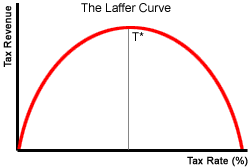Basics
What is fiscal policy?Fiscal policy is the use of government taxation, spending and borrowing to satisfy macroeconomic goals.
Potential GDPThe GDP that results from an economy operating at full employment with full utilization of capital is called potential GDP.
A reduction in after-tax wages will occur with the enactment of an income tax. The supply curve of labor will therefore shift up and to the left. The new equilibrium quantity of labor hired will be less than what would have occurred with potential GDP. There will be a "wedge" between before-tax and after-tax wage rates. Taxes on expenditure increase the size of the "wedge" and further reduce employment.
Keynesians argue that if output is less than what would occur at full employment, fiscal policy should be used to stimulate aggregate demand.
There are three major ways in which fiscal policy affects aggregate demand:
1.Business Tax Policy - Business taxes can change the profitability of businesses and the amount of business investment. Lowering business taxes will increase aggregate demand and business investment spending.
2.Government Spending - Government can directly increase aggregate demand by increasing its spending.
3.Tax Policy for Individuals - Lowering taxes will increase disposable personal income and increase consumption spending.
From the Keynesian viewpoint, fiscal policy should be used to increase aggregate demand when an economy is operating at below full-employment levels. Ideally, the economy will be guided to output at the level of full employment.
If aggregate demand exceeds aggregate supply and output is at full-employment levels, fiscal policy should be used to reduce aggregate demand. This will push the economy to a point of noninflationary equilibrium.
The Supply Side Model is an economic theory holding that bolstering an economy's ability to supply more goods is the most effective way to stimulate economic growth. Supply-side theorists advocate income tax reduction because it increases private investment in corporations, facilities, and equipment.
The Laffer curve shows the relationship between tax rates and tax revenue.
Figure 4.6: The Laffer Curve
This graph shows that as the tax rate increases from zero, the amount of tax revenue collected will increase. At point T*, however, increases in the tax rate lead to decreases in the tax revenue collected. High tax rates also produce a loss to society in the sense that productive economic activity is being discouraged.
Governments would like to be at point T*, because it is the point at which the government collects maximum amount of tax revenue while people continue to work hard. This would theoretically be the point at which potential GDP is maximized.
Supply-side economists believe that high marginal tax rates, such as those experienced in theU.S. U.S.
Tax policy also has consequences at a global level.Ireland has significantly reduced its personal and corporate tax rates; during the 1990s its growth rate was much higher than the rest of Europe . There is an association with high European tax rates and slow rates of economic growth.
What is fiscal policy?Fiscal policy is the use of government taxation, spending and borrowing to satisfy macroeconomic goals.
Potential GDPThe GDP that results from an economy operating at full employment with full utilization of capital is called potential GDP.
A reduction in after-tax wages will occur with the enactment of an income tax. The supply curve of labor will therefore shift up and to the left. The new equilibrium quantity of labor hired will be less than what would have occurred with potential GDP. There will be a "wedge" between before-tax and after-tax wage rates. Taxes on expenditure increase the size of the "wedge" and further reduce employment.
Keynesians argue that if output is less than what would occur at full employment, fiscal policy should be used to stimulate aggregate demand.
There are three major ways in which fiscal policy affects aggregate demand:
1.Business Tax Policy - Business taxes can change the profitability of businesses and the amount of business investment. Lowering business taxes will increase aggregate demand and business investment spending.
2.Government Spending - Government can directly increase aggregate demand by increasing its spending.
3.Tax Policy for Individuals - Lowering taxes will increase disposable personal income and increase consumption spending.
From the Keynesian viewpoint, fiscal policy should be used to increase aggregate demand when an economy is operating at below full-employment levels. Ideally, the economy will be guided to output at the level of full employment.
If aggregate demand exceeds aggregate supply and output is at full-employment levels, fiscal policy should be used to reduce aggregate demand. This will push the economy to a point of noninflationary equilibrium.
The Supply Side Model is an economic theory holding that bolstering an economy's ability to supply more goods is the most effective way to stimulate economic growth. Supply-side theorists advocate income tax reduction because it increases private investment in corporations, facilities, and equipment.
The Laffer curve shows the relationship between tax rates and tax revenue.
Figure 4.6: The Laffer Curve
This graph shows that as the tax rate increases from zero, the amount of tax revenue collected will increase. At point T*, however, increases in the tax rate lead to decreases in the tax revenue collected. High tax rates also produce a loss to society in the sense that productive economic activity is being discouraged.
Governments would like to be at point T*, because it is the point at which the government collects maximum amount of tax revenue while people continue to work hard. This would theoretically be the point at which potential GDP is maximized.
Supply-side economists believe that high marginal tax rates, such as those experienced in the
Tax policy also has consequences at a global level.
 |






0 comments:
Post a Comment